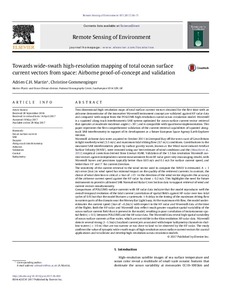| dc.contributor.author | Martin, Adrien C.H. | |
| dc.contributor.author | Gommenginger, Christine | |
| dc.date.accessioned | 2019-04-02T14:41:17Z | |
| dc.date.available | 2019-04-02T14:41:17Z | |
| dc.date.issued | 2017 | |
| dc.identifier.citation | Martin, A.C.H. and Gommenginger, C. (2017) Towards wide-swath high-resolution mapping of total ocean surface current vectors from space: Airborne proof-of-concept and validation. Remote Sensing of Environment, 197, pp.58-71. DOI:
https://doi.org/10.1016/j.rse.2017.05.020. | en_US |
| dc.identifier.uri | http://hdl.handle.net/11329/891 | |
| dc.identifier.uri | http://dx.doi.org/10.25607/OBP-437 | |
| dc.description.abstract | Two-dimensional high-resolution maps of total surface current vectors obtained for the first time with an airborne demonstrator of the innovative Wavemill instrument concept are validated against HF radar data and compared with output from the POLCOMS high-resolution coastal ocean circulation model. Wavemill is a squinted along-track interferometric SAR system optimized for ocean surface current vector retrieval that operates at moderate incidence angles (∼30°) and is compatible with spaceborne implementation. This paper represents the first comprehensive validation of the current retrieval capabilities of squinted along-track SAR interferometry in support of its development as a future European Space Agency Earth Explorer mission.
Wavemill airborne data were acquired in October 2011 in Liverpool Bay off the west coast of Great Britain in light southerly wind (5.5 m/s) and maximum tidal ebbing flow (0.7 m/s) conditions. Contributions to the measured SAR interferometric phase by surface gravity waves, known as the Wind-wave induced Artefact Surface Velocity (WASV), were removed using our best estimate of wind conditions and the (Mouche et al., 2012) empirical correction derived from Envisat ASAR. Validation of the 1.5 km resolution Wavemill current vectors against independent current measurements from HF radar gives very encouraging results, with Wavemill biases and precisions typically better than 0.05 m/s and 0.1 m/s for surface current speed, and better than 10° and 7° for current direction.
The sensitivity of the current retrieval to the wind vector used to compute the WASV is estimated. A ± 1 m/s error (bias) in wind speed has minimal impact on the quality of the retrieved currents. In contrast, the choice of wind direction is critical: a bias of ± 15° in the direction of the wind vector degrades the accuracy of the airborne current speed against the HF radar by about ± 0.2 m/s. This highlights the need for future instruments to provide calibrated SAR Normalised Radar Cross Section data to support retrieval of wind and current vectors simultaneously.
Comparisons of POLCOMS surface currents with HF radar data indicate that the model reproduces well the overall temporal evolution of the tidal current (correlation of spatial fields against HF radar over two tidal cycles of 0.9) but that the model features a systematic 1-h delay in the timing of the maximum ebbing flow in eastern parts of the domain near the Mersey Bar Light buoy. At the maximum ebb flow, the model underestimates the current speed (bias of −0.2m/s) with respect to the HF radar and Wavemill data at the time of the flights. Both the HF radar and Wavemill data reflect much greater snapshot spatial variability of the ocean surface current field than is present in the model, resulting in poor correlation of instantaneous spatial fields (< 0.5) between POLCOMS and the HF radar data. The Wavemill data reveal high spatial variability of ocean surface currents at fine scales, which are not visible in the 4km resolution HF radar data. Wavemill detects several strong (1–1.5m/s) localized current jets associated with deeper bathymetry channels in shallow waters (< 10 m) that are too narrow or too close to land to be observed by the HF radar. The study confirms the value of synoptic wide-swath maps of high-resolution ocean surface current vectors for coastal applications and to validate and develop high-resolution ocean circulation models. | en_US |
| dc.language.iso | en | en_US |
| dc.rights | Attribution 4.0 | * |
| dc.rights.uri | http://creativecommons.org/licenses/by/4.0/ | * |
| dc.subject.other | Ocean surface current | en_US |
| dc.subject.other | SAR | en_US |
| dc.subject.other | Doppler | en_US |
| dc.subject.other | Along-track interferometry | en_US |
| dc.subject.other | Airborne bathymetry | en_US |
| dc.title | Towards wide-swath high-resolution mapping of total ocean surface current vectors from space: Airborne proof-of-concept and validation. | en_US |
| dc.type | Journal Contribution | en_US |
| dc.description.refereed | Refereed | en_US |
| dc.format.pagerange | pp.58-71 | en_US |
| dc.identifier.doi | http://dx.doi.org/10.1016/j.rse.2017.05.020 | |
| dc.subject.parameterDiscipline | Parameter Discipline::Physical oceanography | en_US |
| dc.bibliographicCitation.title | Remote Sensing of the Environment | en_US |
| dc.bibliographicCitation.volume | 197 | en_US |
| dc.description.eov | Surface currents | en_US |
| dc.description.bptype | Guide | en_US |
| obps.contact.contactemail | admartin@noc.ac.uk | |
| obps.resourceurl.publisher | https://www.sciencedirect.com/science/article/pii/S0034425717302195 | en_US |
 Repository of community practices in Ocean Research, Applications and Data/Information Management
Repository of community practices in Ocean Research, Applications and Data/Information Management

